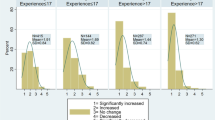Abstract
Data envelopment analysis (DEA) has often been used to evaluate efficiency in the context of higher education institutions. Yet there are numerous alternative nonparametric measures of efficiency available. This paper compares efficiency scores obtained for institutions of higher education in England, 2013–2014, using three different methods: the original Charnes et al. method and two slacks-based methods (SBM-Min and SBM-Max) developed by Tone. The findings suggest that results are highly sensitive to methodology chosen. Hence caution is required in applying the results in any policy context.
Similar content being viewed by others
References
Agasisti, T., & Johnes, G. (2009). Beyond frontiers: Comparing the efficiency of higher education decision making units across more than one country. Education Economics, 17, 59–79.
Agrell, P. J., & Bogetoft, P. (2013). Benchmarking and regulation (CORE Discussion Paper). Retrieved from https://doi.org/uclouvain.be
Athanassopoulos, A., & Shale, E. (1997). Assessing the comparative efficiency of higher education institutions in the UK by means of data envelopment analysis. Education Economics, 5, 117–134.
Banker, R., Charnes, A., & Cooper, W. W. (1984). Models for the estimation of technical and scale efficiencies in data envelopment analysis. Management Science, 30, 1078–1092.
Bonaccorsi, A., Daraio, C., & Simar, L. (2007). Efficiency and productivity in European universities: Exploring trade-offs in the strategic profile. In A. Bonaccorsi & C. Daraio (Eds.), Universities and strategic knowledge creation. (pp. 144–206). Cheltenham: Edward Elgar.
Charnes, A., Cooper, W. W., & Rhodes, E. (1978). Measuring the efficiency of decision making units. European Journal of Operational Research, 2, 429–444.
Daraio, C., Bonaccorsi, A., & Simar L. (2014). Rankings and university performance: A conditional multidimensional approach. Retrieved from https://doi.org/risis.eu
Färe, R., & Lovell, C. A. K. (1978). Measuring the technical efficiency of production. Journal of Economic Theory, 19, 150–162.
Farrell, M. J. (1957). The measurement of productive efficiency. Journal of the Royal Statistical Society A, 120, 253–290.
Flegg, A. T., Allen, D. O., Field, K., & Thurlow, T. W. (2014). Measuring the efficiency of British universities: A multi-period data envelopment analysis. Education Economics, 12, 231–249.
Hadi-Vencheh, A., Jablonsky, J., & Esmaeilzadeh, A. (2015). The slack based measure model based on supporting hyperplanes of production possibility set. Expert Systems with Applications, 42, 6522–6529.
Higher Education Statistics Agency. (2015). Finances of higher education institutions. Cheltenham: Author.
Johnes, G., & Johnes, J. (2013). Efficiency in the higher education sector: A technical exploration. Department of Business, Innovation and Skills Research Paper 113. Retrieved from https://doi.org/www.gov.uk
Johnes, J. (2006). Data envelopment analysis and its application to the measurement of efficiency in higher education. Economics of Education Review, 25, 273–288.
Johnes, J. (2008). Efficiency and production change in the English higher education sector from 1996/7 to 2004/5. Manchester School, 76, 653–674.
Joumady, O., & Ris, C. (2005). Performance in European higher education: A non-parametric production frontier approach. Education Economics, 13, 189–205.
Pastor, J. T., Ruiz, J. L., & Sirvent, I. (1999). An enhanced DEA Russell graph efficiency measure. European Journal of Operational Research, 115, 596–607.
Simar, L., & Wilson, P. W. (1998). Sensitivity analysis of efficiency scores: How to bootstrap in nonparametric frontier models. Management Science, 44, 49–61.
Smith, P. C., & Street, A. (2006). Analysis of secondary school efficiency: Final report. Department for Education and Skills. Retrieved from https://doi.org/webarchive.nationalarchives.gov.uk
Thanassoulis, E., Kortelainen, M., Johnes, G., & Johnes, J. (2011). Costs and efficiency of higher education institutions in England: A DEA analysis. Journal of the Operational Research Society, 62, 1282–1297.
Tone, K. (2001). A slacks based measure of efficiency in data envelopment analysis. European Journal of Operational Research, 130, 498–509.
Tone, K. (2015). Slacks based measure variations revisited. INFORMS Conference, Philadelphia, November 3. Retrieved from https://doi.org/grips.repo.nii.ac.jp
Wolszczak-Derlacz, J., & Parteka, A. (2011). Efficiency of European public higher education institutions: A two-stage multicountry approach. Scientometrics, 89, 887–917.
Author information
Authors and Affiliations
Corresponding author
Rights and permissions
About this article
Cite this article
Johnes, G., Tone, K. The efficiency of higher education institutions in England revisited: comparing alternative measures. Tert Educ Manag 23, 191–205 (2017). https://doi.org/10.1080/13583883.2016.1203457
Received:
Accepted:
Published:
Issue Date:
DOI: https://doi.org/10.1080/13583883.2016.1203457




